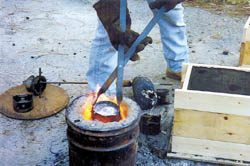
When he couldn't find replacement pistons for an old car engine, Steve Chastain decided to make his own. Using a pop can for a mold, he cast his first pistons, melting aluminum over a charcoal fire.
"Never let a lack of materials keep you from doing what you want to do," says Chastain, author of three books on metal casting, including his latest on making your own pistons.
Readers of his first two books, Metal Casting: A Sand Casting Manual for the Small Foundry, Vol. 1 & 2, know that building a foundry Chastain's way is easy. All you need is a 5-gal. bucket lined with sand and refractory clay. A piece of 4-in. diameter steel pipe with a bottom welded on it makes a pot. Fill the lined bucket with charcoal and the pot with aluminum and light the charcoal.
"It takes about 20 minutes to melt a pot of aluminum with charcoal," says Chastain.
Not only will the simple foundry work once, but Chastain estimates it can probably be refired 50 times before it would have to be relined.
In his new book, Making Pistons, he puts his foundry knowledge to use to replace hard-to-find pistons. This book is designed for the serious automotive enthusiast with experience in foundry work. Foundry terms such as sprue, gates and venting are used without explanation. He describes in detail the desired cooling of the molten metal to attain the optimum strength.
He walks the reader through a technical explanation of determining head thickness and design for heat flow. Special attention is paid to the role of the rings and designing proper ring lands for high loads and temperature.
Once the design has been completed, Chastain takes the reader through the process of making a pattern for the blank, a core box for molding a sand core, and creating the mold itself.
The key here is in accurately reproducing the original piston. Although his early attempts relied on table saw and dowels, he recommends using a lathe to get the shape as exact as possible.
The final step before casting the piston is making and then placing the core. "I use a mixture of wheat flour, molasses and sand for the core and then bake it like a cookie," he says. "It sets up hard like a brick, but after melted metal has been poured around it, the molasses burns out. When you take the piston blank out, the core pours out like dry sand."
Once the pour has been made, Chastain walks the project through to completion, milling out the piston, cutting grooves and using the lathe.
This is not piston making for dummies. It requires a strong basic knowledge of metal work and the right tools from wood and metal lathes to drills, and calipers.
Chastain has come a long way from making pistons with pop cans for pattern blanks and using 5-gal. pails for a furnace. The basic reason for doing what he does has remained the same.
"One outfit was selling a set of pistons for a 1930 Dodge, and it would take six months before I could get them," he explains. "It took me 7 to 10 days and about much less to make my own."
